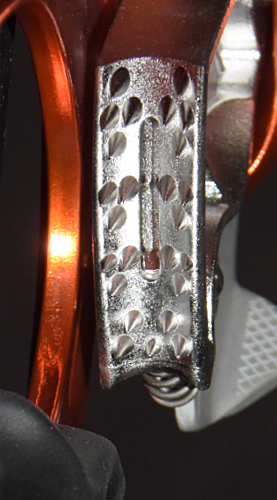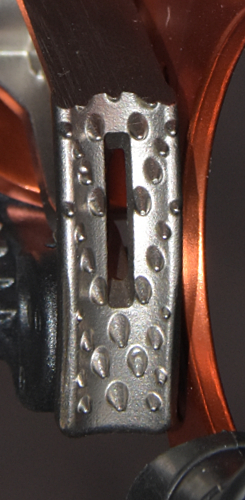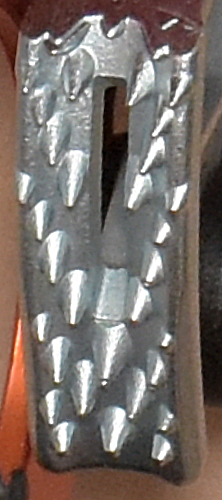Overview
[ Top
| Version B
| Version C
| Return to H.E.C. Ascenders
]
Version A
(#2323)
Technical Details
I acquired this Asol version from Kangjin Liao in 2017.
This version is 191 mm. tall, 89 mm. wide, 27 mm. thick, and weighs 205 g.
 The shell is a tall irregular shaped stamping made from 3.9 mm.
aluminum alloy sheet metal. The upper part of the shell has a stamped reinforcing ridge that extends down into the handle. A 16 mm. rope channel is formed in the upper
portion of one side and a smaller cam channel lies opposite the
first. A hole drilled through both sides of the cam channel accepts
a 5.5 mm. semi-tubular rivet. The cam and cam spring are mounted
on this rivet. The handle below the cam has a soft black rubbery hand grip
molded into place. The hand grip has four finger grooves. A 15.3 mm.
sling attachment hole is punched below the handle opening and a smaller 10.6 mm. hole is punched outside the first. Neither
hole is beveled. A 17.2 mm. hole through both sides
of the rope channel provides an attachment point just above the
cam. This hole is beveled.
The shell is a tall irregular shaped stamping made from 3.9 mm.
aluminum alloy sheet metal. The upper part of the shell has a stamped reinforcing ridge that extends down into the handle. A 16 mm. rope channel is formed in the upper
portion of one side and a smaller cam channel lies opposite the
first. A hole drilled through both sides of the cam channel accepts
a 5.5 mm. semi-tubular rivet. The cam and cam spring are mounted
on this rivet. The handle below the cam has a soft black rubbery hand grip
molded into place. The hand grip has four finger grooves. A 15.3 mm.
sling attachment hole is punched below the handle opening and a smaller 10.6 mm. hole is punched outside the first. Neither
hole is beveled. A 17.2 mm. hole through both sides
of the rope channel provides an attachment point just above the
cam. This hole is beveled.
The cam is a stainless steel casting with a hybrid form consising of a large opening behind the mud slot, a smaller oepning behind this, and a reinforced partial web filling the remainder. The cam radius increases from 36 to 52 mm. over an angle of 38°, giving a 30° cam angle. The cam has number of small conical sloping teeth. The tooth pattern is (2.4)(1S1.2S2)^2(1S1)(2.3) where the "S" represents a single longitudinal mud slot. Like many other ascenders, the inner cam face radius reduces from top to bottom to accommodate various sized ropes.
A spring-loaded manual safety tab is attached to the cam with a semi-tubular rivet. The safety is stamped from 2.5 mm. aluminum alloy. The lower portion is bent outward about 60° to form a thumb tab. The top of the tab has a stamped checkered pattern. The spring is a compression spring that fits over a post on the base of the cam and a small tab on the stamped safety. The normal action of the spring holds the safety against the cam. When the cam is opened, the shell interferes with the safety, thus preventing opening the cam. If the safety is moved away from the cam (opposing the spring), it will clear the shell and the cam will open. At full open the safety can be released and the spring will hold the safety against the back of the shell. This provides a means of locking the cam open.
The front of the ascender is printed with a hollow up-pointing arrow containing "UP" and "Max 4kn," "USE ROPE ¥8<Ø<13," the Asol logo, "QSA01R," "CE 1019," and "EN 567." The rear is printed with "PICC."
The Asol is one of the following ascenders, all sharing the same design with differences only in the color of the anodizing and in the markings.
I acquired the Asol, Version A and
NTR, Version B
as a pair, ordering them at the same time and from the same vendor in China. Interestingly,
they were not priced the same. The Naxen also came from China. The
Proverti CD 211L & CD 212L came
to me from Poland and LACD is a German company, but I believe their ascenders were manufactured in China as well.
These are well-made ascenders and
perform much like the Petzl Ascension.
All sharp edges have been removed. The attachment points are simple
holes in the shell. They have sharp edges that should be rounded with a file; even so, I would consider
their small radius too sharp for directly attaching sling ropes.
They are probably acceptable for webbing, but considering
the proximity of the attachment points to the main rope, I would
recommend using a small maillon for most attachments in order
to reduce the risk of sling abrasion. The lower attachment hole
could theoretically have the same safety problems as the one on
Clog Version A.
The upper rope attachment
hole is located very close to the main rope. A carabiner through
the upper attachment hole will probably drag on the main line.
Note that such a carabiner will prevent putting the ascender on
or off rope, so one's climbing system must be designed accordingly.
I'm not sure the extra holes are needed at the base. Except for the Petzl Pompe, I've never found a real need for a second hole. Some people like them, and I might find them more appealing if they were large enough for a standard carabiner to fit through.
The ribbed handgrips are almost large enough to be comfortable for my large hands, provided I don't wear gloves. In any case, I
don't climb by gripping ascenders at their handle. I think it is better to simply grasp the ascender
from above and lift the ascender in the traditional manner (unless, of course, you are one of those who prefers to climb Frog).
The cam is very well made. The cam stop is placed in a position
where it will not touch the cam if the ascender is off rope.
I don't see much need for cam stops, most
active cavers don't weight enough to bend their ascenders to failure
by cam pull-through, and there is no need to shock load one's
ascenders.
The tab on the safety is rather small and slopes downward, allowing one's thumb to slip off rather easily.
The cam casting is designed so that it could be used with a plastic safety instead.
Although these ascenders are essentially identical, the acceptable rope size ranges printed on the ascenders varies from one to another.
This ascender has the same pit lip disadvantage as the
Clog and other stamped frame ascenders,
although the reinforcing will help prevent bending.
[ Top
| Version A
| Version C
| Return to H.E.C. Ascenders
]
Version B
(#2358, 2370)
Technical Details
I acquired two left-hand ascenders of this Asol version from Kangjin Liao in 2018.
This version is 195 mm. tall, 94 mm. wide, 25 mm. thick, and weighs 173 g.
 The shell is a tall irregular shaped stamping made from 2.9 mm.
aluminum alloy sheet metal. The upper part of the shell has a stamped reinforcing ridge that extends down into the handle. A 15 mm. rope channel is formed in the upper
portion of one side and a smaller cam channel lies opposite the
first. A hole drilled through both sides of the cam channel accepts
a 5 mm. rivet. The cam and cam spring are mounted
on this rivet. The handle below the cam has a soft black rubbery hand grip
molded into place. The hand grip has an index finger support. A 26.8 mm. by 16 mm.
sling attachment hole is punched below the handle opening. A 15 mm. by 15.5 mm. hole through both sides
of the rope channel provides an attachment point just above the
cam.
The shell is a tall irregular shaped stamping made from 2.9 mm.
aluminum alloy sheet metal. The upper part of the shell has a stamped reinforcing ridge that extends down into the handle. A 15 mm. rope channel is formed in the upper
portion of one side and a smaller cam channel lies opposite the
first. A hole drilled through both sides of the cam channel accepts
a 5 mm. rivet. The cam and cam spring are mounted
on this rivet. The handle below the cam has a soft black rubbery hand grip
molded into place. The hand grip has an index finger support. A 26.8 mm. by 16 mm.
sling attachment hole is punched below the handle opening. A 15 mm. by 15.5 mm. hole through both sides
of the rope channel provides an attachment point just above the
cam.
The cam is a steel casting. The cam has
number of small conical teeth, all of which have their axes approximately
parallel to the upper surface of the cam. The cam radius increases from 37 to 54 mm. over an angle of 38°, giving a 30° cam angle. The tooth pattern is (3.4)(1S1)^2(2S2)(1S1)^3(2.3.2.2.3) where the S stands for a central slot. Like the other ascenders, the inner cam face radius
reduces from top to bottom to accommodate various sized ropes.
A spring-loaded plastic safety is mounted on the bottom of
the cam with a steel rivet. The normal action
of the spring holds the safety against the cam. When the cam is
opened, the shell interferes with the safety bar, thus preventing
opening the cam. If the safety bar is moved away from the cam
(opposing the spring), it will clear the shell and the cam will
open. At full open the safety can be released and the spring will
hold the safety against the back of the shell. This provides a
means of locking the cam open. A knob on the safety bar assists
in operating the safety mechanism.
The front of the ascender is printed with a hollow up-pointing arrow containing "UP" and "Max 4kn," "USE ROPE ¥8<Ø<13," the Asol logo, "QSA01L," "CE,"EN 567," and "EN12841." The rear is printed with "EN 567:2013 100Kgs," "EN12841:2006B 140Kgs," and "PICC."
These ascenders have the same design, with differences only in the color of their anodizing and in their markings:
These are well-made ascenders and
perform much like the Petzl Ascension.
All sharp edges have been removed. The attachment points are simple
holes in the shell. They have sharp edges that should be rounded with a file; even so, I would consider
their small radius too sharp for directly attaching sling ropes.
They are probably acceptable for webbing, but considering
the proximity of the attachment points to the main rope, I would
recommend using a small maillon for most attachments in order
to reduce the risk of sling abrasion.
The upper rope attachment
hole is located very close to the main rope. A carabiner through
the upper attachment hole will probably drag on the main line.
Note that such a carabiner will prevent putting the ascender on
or off rope, so one's climbing system must be designed accordingly.
The handgrips are almost large enough to be comfortable for my large hands, provided I don't wear gloves. In any case, I
don't climb by gripping ascenders at their handle. I think it is better to simply grasp the ascender
from above and lift the ascender in the traditional manner (unless, of course, you are one of those who prefers to climb Frog).
The cam is very well made. The cam stop is placed in a position
where it will touch the cam if the ascender is off rope.
This keeps the face of the cam away from the inner surface of the rope groove, a nice but unnecessary feature. I don't see much need for cam stops, most
active cavers don't weight enough to bend their ascenders to failure
by cam pull-through, and there is no need to shock load one's
ascenders.
The safety has a ribbed thumb surface. One-handed operation is smooth and comfortable.
These ascenders have the same pit lip disadvantage as the
Clog and other stamped frame ascenders,
although the reinforcing will help prevent bending.
The lower attachment hole is large enough to accommodate two normal carabiners, but I don't think carabiners are the best way to attach caving slings to ascenders, as there is too much chance of having the ascender slide down and load the carabiner gate.
I'm not sure the extra holes are needed at the base. Except for the Petzl Pompe, I've never found a real need for a second hole. Some people like them, and I might find them more appealing if they were large enough for a standard carabiner to fit through.
[ Top
| Version A
| Version B
| Return to H.E.C. Ascenders
]
Version C
(#3478)
 Technical Details
Technical Details
I acquired a right-hand Asol, Version C from Kangjin Liao (e4store) in 2021.
My version C is 195 mm. tall, 94 mm. wide, 25 mm. thick, and weighs 178 g.
Version C is identical to Version B except the cam has a bright plating.
The front of the ascender is printed with a hollow up-pointing arrow containing "UP" and "Max 4kn," "USE ROPE ¥8<Ø<13," the Asol logo, "QSA01R," "CE,"EN 567," and "EN12841." The rear is printed with "EN 567:2013 100Kgs," "EN12841:2006B 140Kgs," and "PICC."
These ascenders have the same design, with differences only in the color of their anodizing and in their markings:
These are well-made ascenders and
perform much like the Petzl Ascension.
All sharp edges have been removed. The attachment points are simple
holes in the shell. They have sharp edges that should be rounded with a file; even so, I would consider
their small radius too sharp for directly attaching sling ropes.
They are probably acceptable for webbing, but considering
the proximity of the attachment points to the main rope, I would
recommend using a small maillon for most attachments in order
to reduce the risk of sling abrasion.
The upper rope attachment
hole is located very close to the main rope. A carabiner through
the upper attachment hole will probably drag on the main line.
Note that such a carabiner will prevent putting the ascender on
or off rope, so one's climbing system must be designed accordingly.
The handgrips are almost large enough to be comfortable for my large hands, provided I don't wear gloves. In any case, I
don't climb by gripping ascenders at their handle. I think it is better to simply grasp the ascender
from above and lift the ascender in the traditional manner (unless, of course, you are one of those who prefers to climb Frog).
The cam is very well made. The cam stop is placed in a position
where it will touch the cam if the ascender is off rope.
This keeps the face of the cam away from the inner surface of the rope groove, a nice but unnecessary feature. I don't see much need for cam stops, most
active cavers don't weight enough to bend their ascenders to failure
by cam pull-through, and there is no need to shock load one's
ascenders.
The safety has a ribbed thumb surface. One-handed operation is smooth and comfortable.
These ascenders have the same pit lip disadvantage as the
Clog and other stamped frame ascenders,
although the reinforcing will help prevent bending.
The lower attachment hole is large enough to accommodate two normal carabiners, but I don't think carabiners are the best way to attach caving slings to ascenders, as there is too much chance of having the ascender slide down and load the carabiner gate.
[ Top
| Version A
| Version B
| Version C
]


